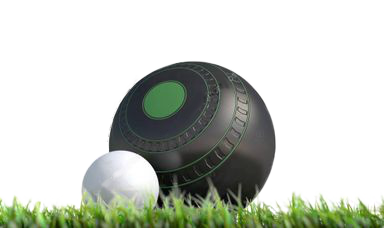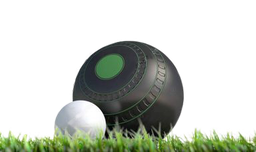The game's afoot
Explanation of the game
Equipment
The game is played on a 16 ft wide 120ft long section of a 120 x 120 ft green. This section of the green is called a Rink. The rink is bounded at each end by a ditch and on each side by an imaginary line defined by markers placed on the bank. A pair of rubber mats are used to define the starting point and a small white ball (called a Jack) is used as the target. Each player has a set of 4 bowls. The number of bowls used by each player will vary depending on the game being played. The bowls look round but are designed to travel in an arc but are marked to show which way the ball will turn.
Object of the game
To get your bowls closer to the Jack than your opponent's closest bowl. (How simple can it be.) Each bowl closer than the opponent's will score one point.
Play of the game
We will assume that the match is being played is a singles game (one v one). Each player will use all four bowls. For the first end a mat is placed on the center line of the rink with the front edge 6ft from the ditch. A coin toss (you will soon learn that no-one uses a coin) decides who starts. The first task is to "set the Jack". The first player stands on the mat and rolls the jack down the rink. The jack must remain within the limits of the rink and come to rest not less than 69 ft from the front edge of the mat. The jack is then moved to the center line of the rink. The first player then stands on the mat and delivers their first bowl. During the delivery the player must keep one foot completely inside the boundaries of the mat. When the first player's bowl comes to rest, the second player takes to the mat and delivers their first bowl. The players then alternate on the mat until all the bowls have been delivered. The players then walk down the rink to admire their handiwork and to determine who was closest to the jack. After the end has been scored a mat is placed at that end of the rink and the process starts over again bowling in the opposite direction. After a predetermined number of ends the player with the most points wins. Want to learn more, go to LINKS and watch some instructional videos.
Rules of the game
The simple version
Number of bowls played - Singles and Pairs are played with 4, 3 or 2 bowls. Triples are played with 3 or 2 bowls and Fours are played with 2 Bowls. (Singles and Pairs mostly play with 4 Bowls and Triples with 3.)
Starting the game - The first end starts with the flip of a coin. The player/team who wins the coin toss has the choice to bowl first or second. After that, the player/team who won the preceding end plays first (places mat, delivers jack and first bowl), while the player/team who lost the preceding end plays second. Club procedure: Each Lead rolls a bowl, with one calling “big or little”. The winning call decides who will bowl first.
Placing the Mat - The mat is placed on the center line of the rink such that the front end of the mat is not less than 2 m (6 ft) from the ditch. A club rule states that this is the position for the first end, for subsequent ends the mat can be placed anywhere along the center line providing that the front edge of the mat is not less than 25 m (82 ft) from the front ditch.
Delivering the jack - The lead bowler of the first team shall roll the Jack down the Rink to a point indicated by the Skip (Captain). The Jack must travel at least 21m (29 ft) and remain within the boundaries of the Rink. Should the jack be closer than 2 m (6 ft) to the front ditch the jack is moved back to the 2m mark. The Jack is centered on the rink by the skip as directed by a player standing on the mat. If the Jack does not travel 21m or goes outside of the boundaries of the rink or fall into the front ditch, the Jack is returned for the lead player of the other team to deliver the Jack. The opposing player has the right to change the position of the mat along the center line of the Rink. The opposing player then guides the skip in centering the Jack but does not deliver the first Bowl, this is the right of the winner of the toss or the winner of the previous end.
End - An "END" involves the playing of the Jack and all the Bowls of each opponent. An End is completed when both teams have agreed to the score or the end is declared Dead.
Dead End - If during the course of play the jack is moved by a "live Bowl" to a position outside the confines of the rink, the end is declared Dead and the end replayed unless the teams agree otherwise. A jack coming to rest in the ditch is still "Live" and will be played to as if it was still on the Rink. A marker may be placed on the bank to indicate the location of the Jack.
POSSESSION OF THE RINK - The player whose turn it is to bowl and his Skip shall have possession of the Rink after the previous Bowl has come to a stop. The player in possession of the Rink can receive instructions from his Skip during this period until his Bowl comes to rest.
FOOT FAULTING - A player, at the moment he delivers the Jack or his Bowl, must have one foot entirely within the confines of the MAT. If a player, after a warning, continues to foot fault the Bowl should be stopped and declared Dead. If the Bowl is not stopped and hits any part of the Head the opposing team shall remove the Dead Bowl and decide whether the head should be reset, remain as disturbed or the entire End be declared Dead.
PLAYING OUT OF TURN - If a player bowls out of turn his Bowl should be stopped and replayed in its proper turn. If the Bowl is not stopped and does not hit any portion of the Head it shall remain as played and the opposing team shall bowl two Bowls. If the offending Bowl touches the Head, the opposing team has the option of allowing the Head to remain as disturbed or declaring a Dead End.
DEAD BOWL - A Bowl is declared Dead if (a) it does not travel 14 m (45 ft 11 in) from the front edge of the Mat, (b) is not a "toucher" and falls into the front ditch or (c) at any time comes to rest beyond the boundaries of the Rink.
TOUCHER - A Toucher is a Bowl that in the course of being bowled touches the Jack before the next Bowl has been delivered. A Bowl is not considered a Toucher if it contacts a Jack that is resting in the front ditch. A Toucher is distinguished by a chalk mark placed on the Bowl. The chalk mark must be removed before the next end. If a Toucher comes to rest in the front ditch and within the boundary of the Rink it remains in play and part of the Head.
MOVED OR DITCHED JACK - If a Jack is moved to a different position on the Rink or into the front ditch within the boundaries of the Rink it shall remain in play and part of the Head.
HEAD DISTURBED BY A PLAYER - If a Jack or Bowl is moved or interfered with by any player while in motion or at rest or in the Ditch, the opposing Skip shall have the option of (a) having the Jack or Bowl replaced to its former position or replayed, (b) remain in its disturbed position, (c) declare it a Dead Bowl and remove it or (d) declare the End Dead.
DISTURBANCE FROM BOWL IN ADJOINING RINK - If a Bowl at rest is likely to be contacted by a Bowl from an adjoining Rink, it may be lifted out of position and replaced to allow the Bowl to pass.
SCORING - Measurements shall be made from the nearest point of the Jack and the Bowl. If the Jack or Bowl is moved at the time of measuring by a player it shall be restored to its former position by an opponent. If some measurements have been agreed to prior to movement of the Jack or Bowl such agreements shall stand. The team having the nearest Bowl to the Jack shall score one point and one additional point for every Bowl that is nearer the Jack than the nearest Bowl of the opponent. The score for an end will be final when both opponents agree and signal the score.
HINT: In the case of multiple points, place a small towel on the Green prior to measuring and then place each scoring bowl on that towel.
THE ABOVE RULES ARE THE MOST COMMON RULES USED IN LAWN BOWLING AND ARE NOT COMPLETE. EVERYONE SHOULD READ THE ENTIRE SET OF THE:
LAWS OF THE SPORT OF BOWLS AND BOWLS USA DOMESTIC REGULATIONS (REVISED 2015)
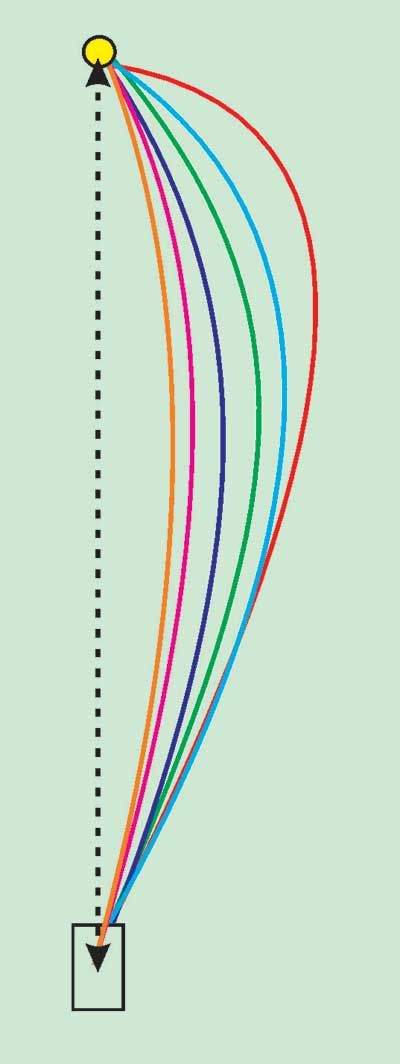
The chart on the left shows the difference in "Bias" of the bowls made by a manufacturer. One set will have less bias (will not turn as much). While other sets having more bias will turn much more. There are advantages and disadvantages to having more or less bias depending on how you play.
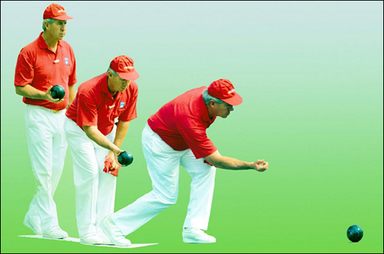
The delivery is made by stepping off with your left foot (right hand player) along the line you want the bowl to travel. This will be a point you have selected to allow for the bias of your bowls. Stepping straight down the rink usually results in the bowl being "Narrow" ie turning across the center line of the rink.
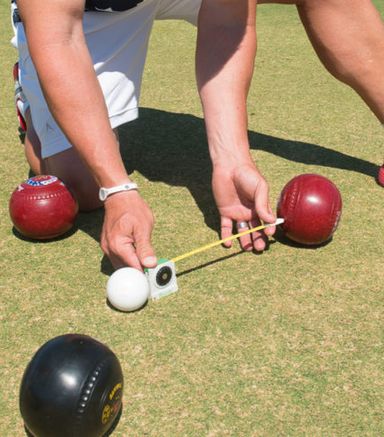
Using a bowls measure to determine the closest bowl: the distance to the first bowl is locked in and then used to determine if another bowl is closer.
We need your consent to load the translations
We use a third-party service to translate the website content that may collect data about your activity. Please review the details in the privacy policy and accept the service to view the translations.
